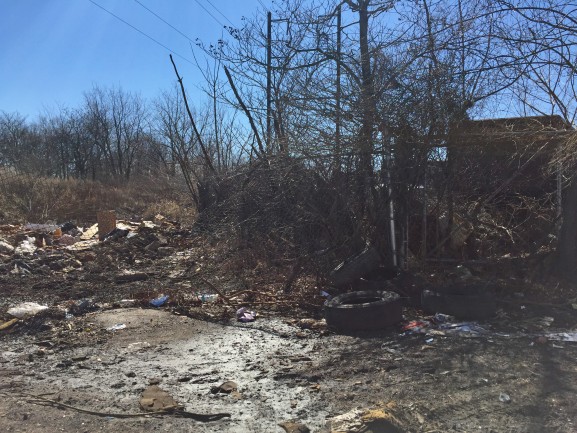
Down on Richmond Street, at the intersection of East Clearfield Street, traffic is sparse. An occasional 18-wheeler drives down the road and most of the stores, from the bakery to the bar to the bookstore, remain empty.
Only a few blocks south, Richmond Street is closed underneath the I-95 underpass. The construction has caused slow business and congested detours in Port Richmond, but what’s to come could make the sleepy town the next bustling river ward.
Caitlin Volz has lived in Port Richmond for three years and isn’t too affected by the construction.
[acf field=”embed_code”]
“The recent construction has caused a bit of detours, but nothing that affects my commute negatively,” Volz said. “They made detour options very easily accessible to my drive into Center City. In the end, when it’s complete, it’ll be great for an improved commute around Port Richmond.”
I-95 is in a long makeover process that will reconstruct the three lanes and improve the interchange at Girard Avenue. The makeover is also targeting streets around the I-95 area, like Richmond Street, which will soon include bicycle lanes and reconstructed rail lines at the Conrail Bridge.
The Pennsylvania Department of Transportation is also working on reconstructing the SEPTA route 15 trolley line, which will connect Richmond Street with Girard Avenue. This will help Port Richmond residents have easy access to surrounding neighborhoods.

East of the construction, on the Delaware River, another makeover is in action. The Delaware River City Corporation (DRCC) is currently working on the Greenway Trail, an extension of the national East Coast Greenway. The East Coast Greenway is an accessible off-road bike and walking trail that hopes to extend 3,000 miles from Maine to Florida.
The DRCC is currently working on an 11-mile stretch for the North Delaware River, from Port Richmond to Torresdale.
Jim Fries has been the project manager at the DRCC for about two and a half years now.
“In the long run what we want to see essentially is the Delaware River front become more like the Schuylkill River front but more connected to the community,” Fries said. “You’ve got that great open space on either side of the Schuylkill River, but the neighborhoods are a mile away. Here, the neighborhoods are kind of close and intertwined.”

The Port Richmond trail is currently done; however, with no connections to other neighborhoods and next to a large industrial park, it gets little use.
On a crisp, bright early spring day, only two ladies can be seen walking around while on a lunch break from work, which is conveniently located right on the trail. Other than that, the trail is empty.
[acf field=”embed_code_2″]
“When I-95’s reconstructed we’ll be looking to work with the designers for PennDot to improve the connections underneath the I-95 underpasses and overpasses,” said Fries.
The DRCC is also looking to improve lighting, signage, graphics and art around the greenway in Port Richmond.
The North Delaware River front as it appears now is a stretch of abandoned ports, industrial warehouses and litter from dump piles. The DRCC’s greenway will add easy walking and biking access to parks like Pennypack and Lardner’s Point.

Bob Borksy is chairman of the board.
“[Borsky] took a bunch of business people, politicians out on the river and went up and down it and showed them this waterfront that was largely abandoned for recycling industries and other things, “ Fries said, “He got them to imagine what it could be if it were reclaimed and there was this green edge with this connectivity and what the impact of that could be on the six neighborhoods that border it.”
The DRCC also hopes to inspire community involvement from the trail. Along with community volunteer groups to help plant trees and pick up trash, there was also a 5k run this past October and the committee is planning for another this upcoming fall.
To the south, the Delaware River Waterfront Corporation handles everything south of Allegheny Avenue. They’re behind the popular pop-up beer garden, Spruce Street Harbor Park and their latest installation, RiverRink Winterfest.
[googlemaps https://www.google.com/maps/d/embed?mid=zOzkTE6X9KfA.kDwzMH_pRmGc&w=640&h=480]
The DRWC controls popular sites like Spring Garden, Penn’s Landing and Washington Avenue, while the DRCC mostly deals with old ports, industrial companies and in some cases, abandoned land.
With the new trail and easier public access through PennDot’s construction, the waterfront’s newfound entertainment might just expand northward.
– Text and images by Regan Abato
[acf field=”embed_code_3″]


DRCC was founded in 2004 by former Congressman Bob Borski after he left office in order to build on the vision he saw while in Congress. Much has been accomplished but much more remains to be done. Great staff work and an engaged Board have made a tremendous difference!